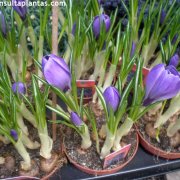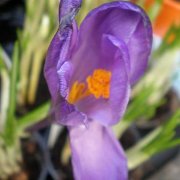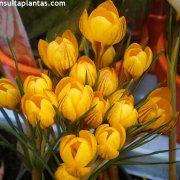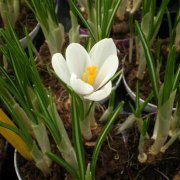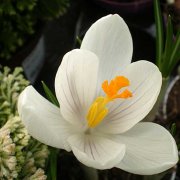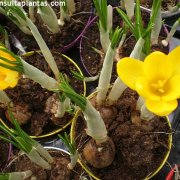Care of the bulbous plant Crocus or Saffron |
|
The genus Crocus, family Iridaceae, includes 90 species of bulbous plants native to the Mediterranean region, central Asia and China. There are a great variety of hybrids. Common name: Saffron. They are small perennial bulbous plants that reach 20 cm (7.87") in height. The fine, ribbed leaves emerge from the bulb and have a central white stripe. The bell-shaped flowers appear in groups of 2 or 3 or solitary and can be white, blue, lilac, violet, yellow, orange or purple. They bloom in different seasons according to the species. - Species that bloom in autumn: Crocus speciosus, Crocus byzantinus, Crocus sativus (Saffron), Crocus longiflorus, Crocus kotschyanus. - Species that bloom in winter and spring: Crocus aureus, Crocus chrysanthus, Crocus biflorus, Crocus imperati, Crocus tomasinianus, Crocus vernus, Crocus susianus, Crocus minimal, Crocus sieberi. Saffron is used on rockeries, on borders, to create colored spots on the lawn or in undergrowth; It's suitable for pots on terraces and balconies. Crocus needs full sun or semi-shade exposure. It must be protected from frost. The soil can be a garden substrate with 1/3 peat, a little manure or humus and 1/3 coarse sand. Planting is done in autumn. Plant the bulbs 7 cm deep and 5 cm apart. Water moderately, waiting for the substrate to dry; overwatering can rot the bulb. Fertilize with compost at the time of planting. Crocus is a resistant and easy to grow plant that do not usually has problems with pests and diseases. Saffron propagates from the bulblets that the plant produces in the central bulb. They separate in summer hoping that the leaves have turned yellow; keep the bulbs in a dry and dark place until planting. |
Images of the bulbous plant Crocus or Saffron |
Find plants
Crocus or Saffron | Care and Growing
© 2026 FavThemes
